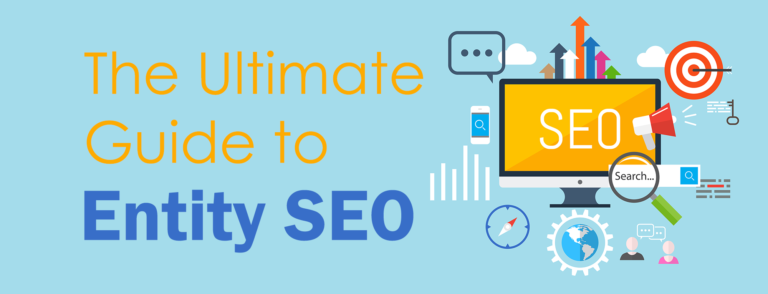The Google algorithm has come far from its early days of keyword stuffing and link building. Its most impactful shift was putting the primary focus on entity-based search engine optimization (SEO) instead of keywords.
Traditional SEO considered keywords and the user intent behind those keywords, which made for a simple approach. But as Google strives to improve search, it digs deeper: it considers multiple factors such as context, user intent, and relationships between words, which make up a modern entity-based SEO.
In this guide, you'll learn:
Entity Based SEO
Entity-based SEO describes a search engine’s attempt to generate the most accurate search engine results by connecting user intent, context, and the relationship between words.
When it comes to language, there are certain nuances only humans can understand; machines often process phrases literally.
Entity SEO connects entities and their meanings, contexts, and intents by building knowledge graphs from Google Knowledge Graph, LinkedIn, Wikidata, or Amazon’s product graph.
For example, a search query for the actor playing the “shiny vampire in Twilight” returns a knowledge panel for Edward Cullen. The panel also mentions “Robert Pattinson,” the actor who played the role.
Google gave us the result without us mentioning the terms “Robert Pattinson” or “Edward Cullen.”
The knowledge graph article that’s in the works can replace this once published
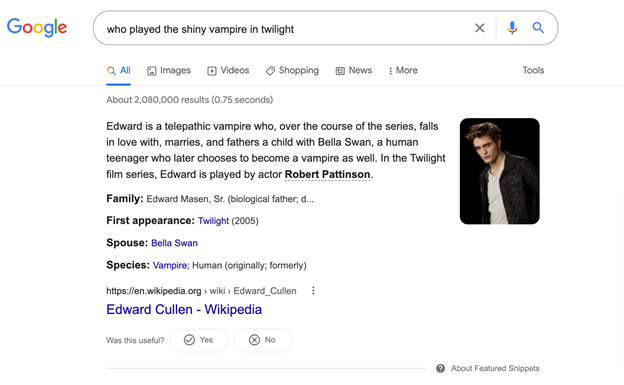
SEO Entity 101
According to Google, an SEO entity is anything that is “singular, unique, well-defined, and distinguishable.”
Through this definition, an entity doesn’t have to be a physical object or tangible; it can also be a color, date, currency, or idea. Unlike keywords, which spell out a word specific to a language, an entity carries meaning and is independent of the language and similar keywords that designate it.
How Entities and Keywords Work Together
In its early days, Google focused on keywords. So why did it shift to using entities?
- Keywords can be ambiguous. Many English words have multiple meanings. For example, think of Apple (brand) and apple (fruit). You will get a bad mix of results when you don’t consider context, search intent, or related terms.
- Keywords are often specific to a language. For example, the keyword “la casa” literally translates to “the house” in English or “la Maison” in French.
- You couldn’t build connections with keywords. In the early days of Google, separate web pages from the same website could rank for multiple variations of keywords because Google couldn’t recognize that these were all related.
When Google shifted to entities, it didn’t completely do away with keywords. It still uses contextual keywords to help define entities. These keywords allow search engines to locate and link your content to similar entities.
Benefits of Entity SEO
The shift to entity search has grown out of how people perform searches. Voice search, personalized search results, and mobile search affect content discoverability and how it’s presented.
Here are a few reasons that showcase the importance of entities:
Better Search Results
Ever since the shift to entity-based SEO, Google has provided a better user experience for searchers.
It improved mobile search results (through mobile-first indexing) and has made new search methods like voice search (through digital assistants) and chatbots possible.
Google has also started to consider different entities and interpret search intent based on various factors such as:
- User search history. Google uses your search history to deliver personalized results. For example, if your recent searches were about WordPress and websites, when you search for the term “staging,” Google might return results for “staging sites” instead of “home staging.”
- Global search history. Google takes global search and current events into account when returning search results.
For example, before the 2020 pandemic, searching for “loss of smell” would’ve likely shown a featured snippet from a medical website. Now, it shows news related to COVID-19.
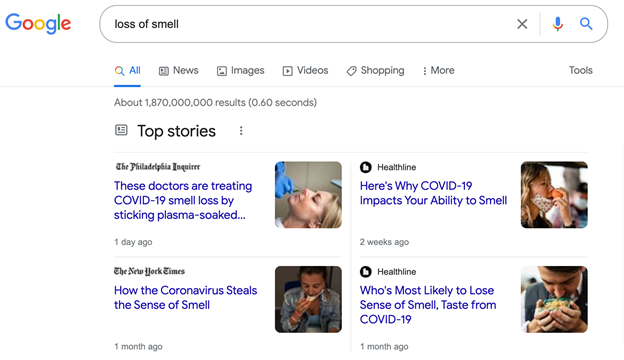
And if you check when the interest in “loss of smell” began to spike, it makes sense.
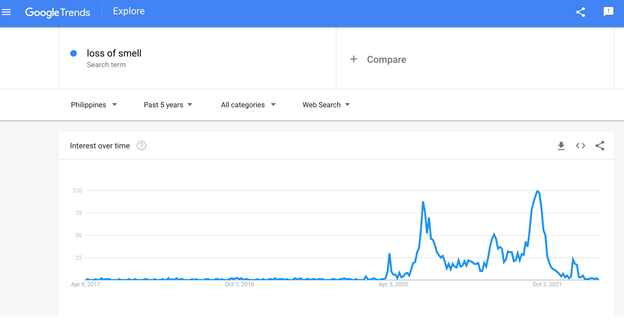
- Search location. Google considers your location to return relevant results. For example, a search for “coffee shop near me” shows coffee shops nearby.
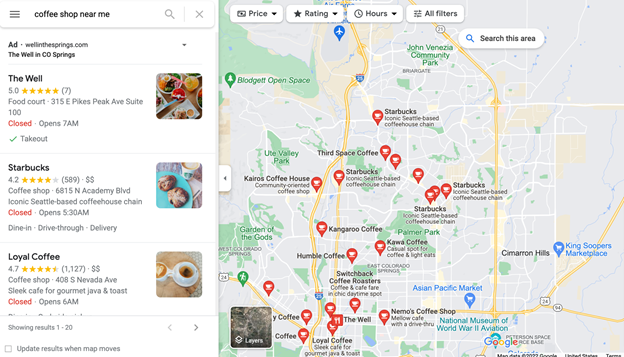
- Spelling variation. Google can return relevant search results despite variations in spelling.
In the example below, Google returns a result for “imposter syndrome” even though the search term was “impostor syndrome.”
Moreover, entity-based SEO does not just benefit searchers; it also helps businesses with discoverability.
Businesses can now rank for keywords that Google previously didn’t consider related to your brand. For example, Nike can rank for terms like “running shoes,” “basketball shoes,” or “tennis shoes.”
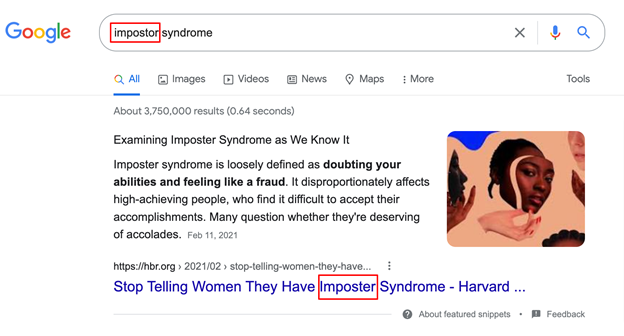
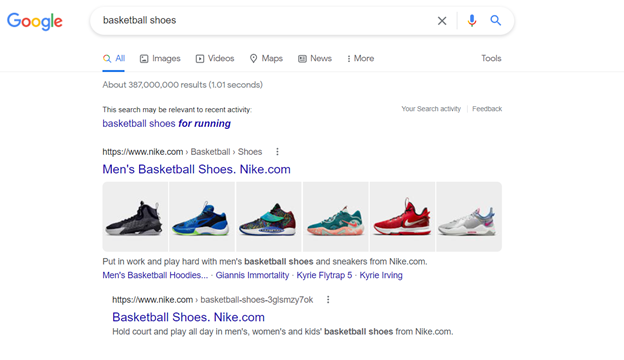
Improved Translations
Search engines recognize entities through synonyms, homonyms, and foreign language context clues. Search results for “red” may also include terms like “rojo” (Spanish) or “rouge” (French) if the searcher’s settings allow it.
Builds Google’s Knowledge Graph
Using entities in SEO helps Google build its knowledge graphs.
These knowledge graphs create rich snippets (or Google results with additional data). Examples of these rich snippets include:
- Google’s featured snippets (which appear before the top result)
- Review scores
- Recipes
- Time and location on event listings
Having an entity-based SEO strategy in place ensures success. We’ll teach you some techniques for building your entity-based SEO strategy at the end of this post.
How do Entities Work?
Now that you know what an entity is and why it’s important let’s look at how knowledge graphs determine relationships between entities.
Dave Davies’ analysis of a 2015 patent formed the basis of modern entity relationships. According to Davies’ research, ranking entities on search considers four factors: relatedness, notability, contribution, and prize.
Relatedness
When you cite and reference two entities together, knowledge graphs will put those two terms together.
For example, “U.S.” and “President” get you this result:
In contrast, searching for “U.S. presidents” will return the following result:

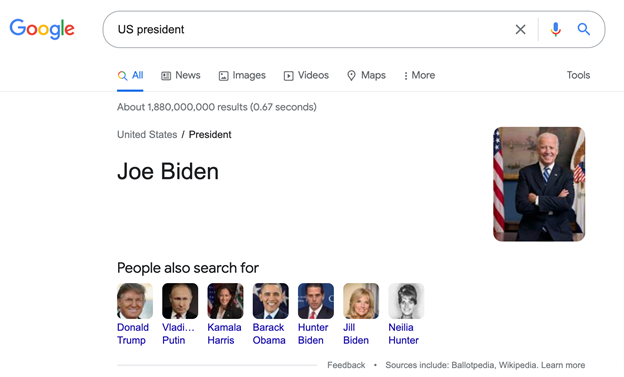
Notability
Google uses a formula (detailed in the patent) to determine the entity’s notability.
Without considering the formula, the concept shows that entities are more notable in low-competition categories. They’re also more valuable when they have more links, reviews, mentions, and relevance.
To picture the concept of notability, you can think of it like long-tailed keywords; the more specific a keyword is, the more likely your content is to rank than if you optimize for a generic short-tail keyword.
You can also compare it to a big fish in a small pond: it’s more notable swimming in a pond than swimming in the ocean.
Contribution
Contribution refers to an entity’s contribution to a topic.
It is determined by external signals like backlinks or reviews. For example, a review or backlink from a more established website will have more consideration than a less respected one.
Prizes
The Prize is exactly what it sounds like.
It measures relevant prizes an entity received, such as the Nobel Prize or Academy Award. The more prestigious the prize, the higher the value attached to the entity.
Putting all that information together, here is what goes on behind the scenes when you search for “best actors”:
- Google determines other entities’ relatedness, notability, contribution, and prizes and assigns values.
- They determine the applicable weights each should have based on the query type.
- Google determines a final score for each possible entity.
Thus, the final search result returns this:

Since “best actors” is subjective, Google opted to return a list of people that have won Best Actor at the Academy Awards.
Google Services that Help with Entity SEO
During the early days of SEO, Google considered keyword density to determine which content would rank. Thus, keyword stuffing, or the practice of adding many relevant and irrelevant keywords, was prevalent.
Now, these black hat SEO practices are frowned upon.
Google has made multiple improvements to its algorithms to prioritize good copy and content. These are the most important Google updates that helped improve search results.
Knowledge Graph
The Google Knowledge Graph is a knowledge base of entities and the relationships between those entities.
The update, released in 2012, enhanced Google’s search engine’s results by gathering information from various sources. It also enabled the shift from keyword matching to semantic matching, helping users discover information faster and easier.
The Knowledge Graph allows Google to present knowledge panels and refine the results of its other services based on user intent.
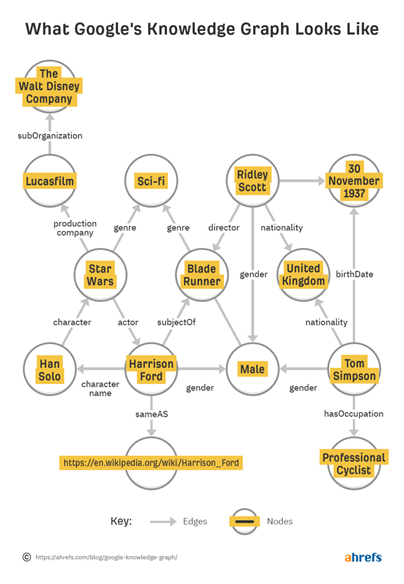
Hummingbird
Google launched the Hummingbird update in 2013 to return better search results for complex queries. It was the first major update that emphasized the meaning of search queries instead of individual keywords and arguably marked the beginning of the semantic search era.
Hummingbird uses natural language processing (NLP) to match search context to results, meaning that the pages that best match search intent and context will rank better. For example, searching for “how to make coffee” will give you different results than “where to buy coffee.”
RankBrain
In 2015, Google launched RankBrain, an algorithm and ranking factor that helps Google sort through the search results.
Like Hummingbird, RankBrain seeks to understand the user intent behind queries. The difference is that RankBrain uses artificial intelligence (AI) and machine learning to test and tweak the algorithm on its own. RankBrain will adjust the weight it assigns to backlinks, content length, content freshness, or domain authority depending on the keyword.
RankBrain is always learning and analyzing the best-performing search results. It looks for similarities between content users find valuable and observes how Google searchers interact with new searches — which is extremely helpful since 15% of search queries are new.
If users like the new algorithm, it stays. If not, it shifts back to the old algorithm.
How to Optimize Your Website for Entity SEO
It’s time to dive into how you can leverage entity SEO for your website. Without further ado, let’s get to it.
1. Fill in Gaps with an Entity Audit
To optimize your website for entity SEO, you should first ensure your site covers the specific topics it should be known for. But how do you do that?
By performing an entity audit.
An entity audit takes stock of a brand’s known entities, compares them with competitors, and ensures that it uses entities strongly associated with the brand.
Doing an entity audit helps you plan and create content for topics your website should be discussing.
2. Build Your Brand Entity
You can start building your brand entity by creating entities for an internal knowledge graph. Here are some ways to do so:
- Build an internal linking structure. Google follows links to discover content on websites. Building an internal link structure does not only aid in navigation but also defines the website’s hierarchy and distributes page authority throughout the website. Google assumes that all these topics are connected when you internally link to other content.
- Connect your content to high E-A-T (expertise, authoritativeness, and trustworthiness) knowledge graphs, such as Wikipedia, Amazon, or LinkedIn. These may not directly affect your page rank, but they can improve your page authority in search. Tip: choose to link to websites with high domain authority.
- List your business in relevant business directories. Google uses online directories or listing services as a data source for the Knowledge Graph.
- Create authoritative content to receive backlinks from websites in your niche.
3. Gain Visibility by Improving Your Website’s Technical SEO
Content isn’t the only thing you should focus on; you should also consider technical SEO.
Technical SEO is SEO work done besides content. It refers to website and server optimizations that help search engine spiders crawl and index your site more effectively. It lays the foundation to give your content the best chance to rank for relevant keywords and phrases.
Here are some ways to improve technical SEO:
- Implement schema markup. Schema markup (or structured data) is a standardized way of providing information about a webpage. On its own, schema markup does not create entities. Instead, it defines objects as distinct entities with their own properties and relationships to other entities.
Once those entities are defined, you can link these to a search engine’s knowledge graph.
- Use semantic HTML: Semantic HTML adds meaning to the code so machines can recognize navigation blocks, headings, footers, tables, or videos.
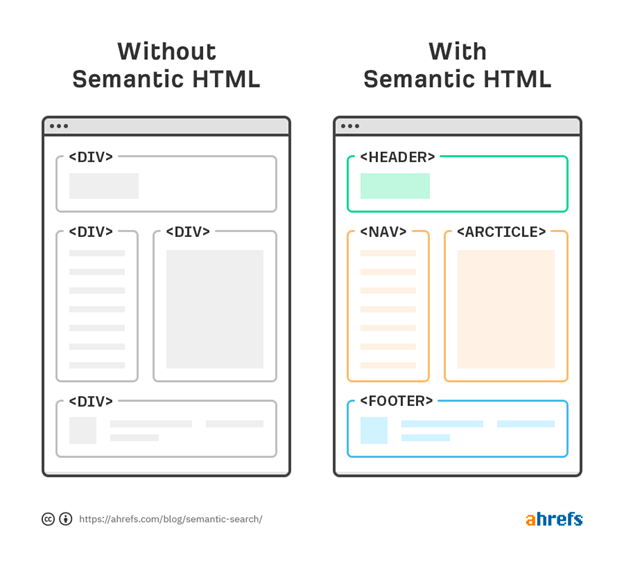
- Create a sitemap. An XML sitemap is a list of URLs on your website. Webmasters can add details about each URL, such as its importance and when it was last updated. Having one allows search engines to crawl your website faster.
4. Create Content for People and Machines
Entity-based SEO is helpful for searchers. Still, it slightly has made things a bit more complicated for content creators because they now have to optimize content for both humans and robots.
Here are some best practices for optimizing content for entity search:
- Target topics, not keywords. In the days before Google’s Panda update, you could have ranked high on search engines with separate pieces of content containing variations of a keyword.
That won’t work now because Google now understands the concept of related terms.
Create in-depth content so that Google ranks your page for similar and long-tail keywords.
- Understand search intent. When crafting website content, take search intent into account. Put yourself in your reader’s shoes: what answers are they looking for?
Once you know what the search intent is, perform keyword research. Different types of keyword indicators align with where users are in the marketing funnel.
Develop targeted content that answers the readers’ questions.
“You may have a brilliant piece of content, but the intent and the expected asset type may affect what is shown to people,” shared Bill Hunt, CEO of Black Azimuth Consulting.
- Write in natural language. The new Google updates have made it possible for search engines to understand the way humans talk and return accurate search queries. Just note you should still avoid ambiguous language.
Final Thoughts — What is Entity SEO? An Introduction to Entity-based SEO
Entities are the most important concept in modern SEO. It improved semantic search, allowing search engines to return better search results.
With this knowledge, you can optimize your website for better content. We shared actionable tips to improve your website for entity SEO.
Contact Infront Webworks for your SEO needs.

Matthew is the President of Infront Webworks and is a New England native now calling Colorado Springs home. Matt attended The University of NH where he pursued a BS in Natural Resource Economics & Business Administration. Aside from Infront; Matthew has owned and managed two other online agencies based on the seacoast of New Hampshire and been a key player in multiple technology mergers & acquisitions. When he’s not bathing in technology, online marketing & business; he’s probably spending time with his wife and daughter, boating, skiing the trees, hiking or cooking..he is a foodie for sure!

